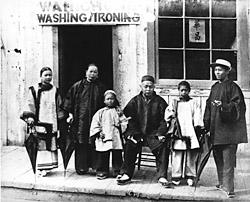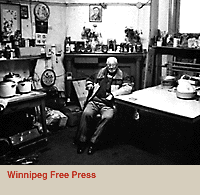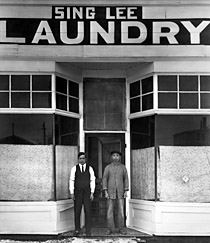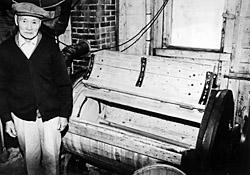
|


|
5. Enduring Hardship — Chinese
Hand Laundry

|
The Wah Chong Laundry, Vancouver, 1884 Courtesy of City of Vancouver Archives |
|
This exhibit recreates the ambience of the Chinese laundries found in
large numbers across Canada between 1900 and the 1950s. The display,
based on extensive fieldwork, incorporates artifacts from various laundries
including those from the Central Laundry operated for many decades in
Winnipeg by the late Ho King. It aims to present the laundry within the
context of our urban life and ethnic and immigration history.
In the reconstructed laundry, visitors first enter a counter area and then a kitchen area where they can view an original documentary showing interviews with the older generation of Chinese laundrymen and their offspring. Moving into the laundry working area, visitors then discover the difficult tasks involved in the washing and boiling process, surrounded by presses, irons and other tools of the trade. They learn of the hard physical work carried out by the laundrymen in a cramped and steamy environment. To many of the laundrymen's descendants, the hand laundry is a symbol not only of hardship but of survival, endurance, patience and sacrifice for the future.
These movies can be viewed with any Quicktime player, but are best viewed using Apple's Quicktime Player. If you wish to download the Quicktime VR Player click on the logo:
From Coast to CoastThe Fraser River gold rush and the construction of the Canadian Pacific Railway, among other developments, brought thousands of Chinese labourers to British Columbia from 1858 to 1885. Following the completion of the CPR, many of these immigrants moved to other parts of the country to continue to search for their dream of the "golden mountain." Many set up laundry businesses in railway towns and cities east of the Rockies and as far away as Quebec, the Maritimes and Newfoundland. From 1890 to 1950, a significant number of Chinese engaged in this trade. For example, in Montreal in 1921, there was a population of 1,735 Chinese with an estimated 368 laundries.
Two factors contributed to the establishment of the Chinese laundries. First, all that was required was a bit of capital and long hours of work, with the owners speaking little English or French. Secondly, the Chinese were discouraged from entering other occupations and were subjected to legal restrictions and socio-economic discrimination. They could only engage in labour-intensive work. Laundrymen experienced social and family isolation. In most cases, their family members were left behind in China. In an era of racial intolerance and fearful of competition from cheap Oriental labour for jobs, some politicians and trade union groups pressured the Dominion Government to severely restrict the numbers of incoming Chinese, Japanese and East Indians. Head taxes and legislative exclusions discouraged the immigration of family members, and ultimately, the Chinese Immigration Act (1923-1947) barred the admission of all Chinese. The hand laundry thus became essentially a man's occupation. Ho King, for example, the proprietor of Winnipeg's Central Laundry, left China in 1918 and was joined by his wife in 1959 - a forty-one year separation. The life of a laundryman was very difficult and monotonous. Most of his time was spent washing, ironing, pressing, packaging and delivering clothes and chopping wood. The work was hard, and the income was very low. Apart from their long hours of work, laundrymen made an occasional trip to Chinatown to buy groceries and have a cup of tea or a game of mahjong with their fellow clansmen and friends.
With few resources and the denial of opportunity, the Chinese community in Canada was relegated to the low end of the socio-economic ladder for more than half a century. With gradual mechanization from the late 1940s to the 1960s, and with the ageing of the earlier Chinese immigrants, the occupation of laundryman inevitably petered out, but it remains an unforgettable part of Chinese-Canadian history. This permanent exhibit both captures and commemorates the essence, life and contributions of the Chinese laundrymen. Further along in the Canada Hall, the Pacific Rim exhibit explores the twentieth-century patterns of Asian immigration, socio-economic activities, and contribution within Canada.
Opened: 12 October 2000 |
||||||


|




